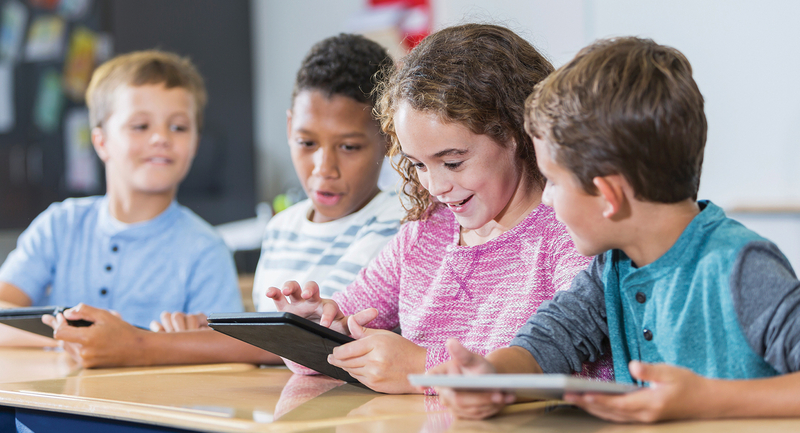Cell phone bans in K–12 schools are on the rise. School leaders and parents are increasingly concerned over teen mental health related to digital devices and social media use. U.S. Surgeon General Dr. Vivek Murthy (2024) has even called for a warning label to be placed on social media as potentially harmful for youth. Yet, as more teens own digital devices and the average age of first ownership decreases—nearly 19 percent of 8 year olds have a smartphone, and nearly 69 percent of 12 year olds have one (Rideout & Robb, 2019)—engagement with these devices and online activities will likely persist, despite growing health concerns.
To navigate the complexities of our digital world, it’s essential for students to develop agency and strong problem-solving skills related to their technology use—and schools play a pivotal role in teaching students how to critically assess and manage screen time. By incorporating lessons on responsible and healthy tech use, educators can provide students with the skills needed to balance their online presence with their overall well-being.
As a professor of teacher education and learning technologies at the University of Michigan School of Education, I have spent the last 20 years preparing new teachers to teach middle school students about healthy habits around screen use. In that time, I’ve learned many lessons about how middle school students view their device use and how best to help them take a mindful and cautious approach with their screen choices.
The Evolving Digital Education Landscape
Over the past two decades, I have observed the focus of digital education move from an emphasis on digital literacies in the early 2000s (keyboarding and basic productivity skills) to digital safety in the 2010s (cyberbullying and stranger danger online) and then pivot from a focus on screen time in 2020 to the current focus on digital wellness (mental and physical well-being when using screens). Each shift has required students to develop new problem-solving skills, adapting to the changing digital landscape.
This newest focus on digital wellness derives from concerns that students are spending an extraordinary amount of time on screens, and new research finds that this type of screen use could impact their mental and physical health (Prinstein, 2023). To address these concerns, educators must help students develop digital problem-solving skills, enabling them to use technology constructively and safely. Yet, no matter the digital education topic du jour, some strategies work better than others when it comes to educating youth about screen use.
It is important to validate students’ complex feelings around digital spaces—the good, the bad, and the confusing.
What Doesn’t Work
Ultimately, the goal of digital education is to change or modify a student’s behavior when using their digital devices and to build students’ knowledge so they can make proactively informed decisions about device use. Historically, schools engaged in activities they thought were beneficial, but they often had little impact on changing students’ behaviors. Below are five common digital education practices that do not tend to have an impact.
1. Guest Speakers: Bringing in a guest speaker to encourage students not to use certain applications, such as social media, has been a common practice in many schools. Since most speakers tend to be adults or authority figures (such as a law enforcement officer or an attorney), students often ignore their messages, sharing with me that they feel disconnected from these adults.
2. Extreme Examples: Schools sometimes use extreme anecdotes of what could happen to youth who engage in screen use, believing it is an effective way to scare them into not doing potentially harmful things online. For example, they might share a story about a child being harmed by an adult because of social media or gaming interactions. While this could happen, it is not a common incident for most children. When hearing extreme stories, students often can’t relate, and it doesn’t create the impact that adults hope it will. Youth tend to relate to subtle examples that are more common in their digital lives, such as a mean comment online, an email scam, or finding out they weren’t invited to a friend’s party that was later shared online. These more likely scenarios tend to have greater impact.
3. One-Off Lessons: There are some useful digital education lesson plans online, such as ISTE’s Digital Citizenship Lessons, but they are rarely used in a comprehensive way where teachers build on them over the course of the school year. Thus, when lessons are used only a few times a year, their impact is significantly reduced compared to being integrated into a comprehensive digital education plan for the entire school district.
4. Online Modules: There are numerous online digital education modules where students watch a series of short videos and then answer questions around digital safety to earn a badge or certificate. While students are really good at doing well on these quizzes, the impact (a change of their behavior) often doesn’t come with the badges they earn. Thus, a “digital citizen” badge does not often lead to students making safer or kinder choices when they are online.
5. List of Dos and Don’ts: Providing students with a list of what they should and should not do online has been fairly ineffective in changing student screen choices. I have found this is especially true if the students did not come up with the list themselves. Schools are likely to get better traction if they allow students to develop their own lists and personalize them to their individual situations. It is important to remember that what is healthy for one student may not be healthy for another.
Student device use is complicated, and the only way to change behavior is to have deep, ongoing, and safe conversations.
What Does Work
Over the past few years, I have seen schools shifting to new approaches that are more comprehensive and focus on student agency around screen use. Here, I share some strategies we have been using at the University of Michigan with middle school students over the past decade that have shown success in changing student behavior.
1. Near-Peer Approach: When adults tell teenagers what to do on their screens, teens often tune out. But when a “near-peer,” someone closer in age to the student, shares about being more careful with devices, it has an impact. Near-peer conversations also create a more comfortable space for teens to share because they tend to be cautious about sharing their personal device experiences with their teachers. They are less shy about sharing with a near-peer who may have experienced something similar online.
For the last decade at the University of Michigan, we have paired UofM teaching interns with middle school students for small-group discussions and activities around digital wellness (https://bit.ly/3Zvu7Vj). The discussions, which are facilitated by college students over the course of a semester, are “no judgement spaces” that allow middle schoolers to safely share their emotions and experiences without worry of criticism. The response by middle school students to this near-peer approach has been overwhelmingly positive. The middle school students have shared that since their teachers are not leading the conversations, they feel less judged about what they share. If schools do not have access to college-age mentors, near-peers could also be older high school students talking with younger students.
2. Small-Group Conversations: Holding a large lecture about screen use is not ideal, as students tend to be hesitant to share intimate details about their online world in larger group settings. Instead, at UofM, we have found that a better option is to create small-group spaces for conversations. Thus, we created an approach where UofM students lead small-group conversations (with four to six middle school students per group) about device usage. The small groups collectively develop norms and then engage in back-and-forth dialogue and game-like activities to support the conversation.
3. Ongoing Conversations: Instead of holding one or two lessons a year on digital education, creating opportunities for ongoing conversation is a way to be both proactive and create space for students to share as things are happening and evolving in their digital worlds. This approach can be taken by setting aside 30 minutes of class each week for digital debriefs and small-group discussion time. It could also be done in a safe online forum (via an LMS) that is monitored by the teacher and counselors.
4. Student Discovery and Agency: When students are given greater agency, they tend to make wiser online decisions. For example, in our small groups, our UofM near-peer facilitators may share a story about their own online experience and ask the students in their group to provide advice, help, and feedback. The middle school students enjoy being put in a position of having some expertise, rather than being told the answers.
5. Provide Facts: Telling young people that they can’t do something (such as creating a TikTok account), without an explanation of why, doesn’t usually prevent them from engaging in a given behavior. Providing youth with evidence-based knowledge about how apps are designed to be addictive and the specific features that contribute to this helps them recognize and understand educators’ concerns better, leading to more cautious online choices. I have often used testimony from the APA chief science officer on addressing the mental health impact of social media on children and teens (Prinstein, 2023) to share facts with students.
6. Parent Involvement: It can be difficult to get caregivers involved, especially at the secondary level, where students tend to have more autonomy and there is less parent volunteerism. But parents are an important part of the equation for young people developing positive mental health habits around their device use. Therefore, schools need to find creative ways to include parents.
At UofM, we have held informational nights for parents of middle school students to share resources. They are most beneficial when parents and their children participate together in activities related to digital wellness, such as the Parent/Youth Digital Wellness Symposiums we host (Kolb & Fontichiaro, 2022). These events are virtual and highly interactive; they include games, conversation starters, and time for collaboration with families. We have received extremely positive feedback from participants (students and parents alike), sharing that the symposiums were helpful in adopting a healthier approach to device use in their families.
7. Acknowledge the Good: Finally, and most importantly, young people do use technology in healthy ways (Common Sense Media, 2024). This should be validated and recognized in conversations with students about screen time. Young people respond well when we talk about how they are using technology to support their friendships, mental health, and academic lives. Using blanket statements such as, “Technology is ruining our youth,” is the quickest way to turn off students. Instead, by asking students how technology helps them and by allowing them to open up, students feel empowered to dig into the complex world of their devices.
Understanding Students’ Digital Realities
Ultimately, student device use is complicated, and the only way to really help change behavior is to have deep, ongoing, and safe conversations with students—not one-time, one-off quick fixes. Through these ongoing dialogues, we can better understand the challenges students face and guide them in developing essential digital problem-solving skills, such as critical thinking, online safety, and responsible decision-making. By fostering an environment where students feel heard and supported, we can equip them with the agency to make informed and mindful choices. Behaviors often change slowly over time, and if we want to help our youth navigate their digital world, we need to find ways to meet them where they are and validate their complex feelings around digital spaces—the good, the bad, and the confusing.
Reflect & Discuss
➛ How can your school or district shift to a proactive and comprehensive approach to teaching students digital wellness?
➛ What strategies have you found effective in helping students develop agency around their digital device use?
➛ How might schools better involve families in promoting healthy digital habits among youth?









